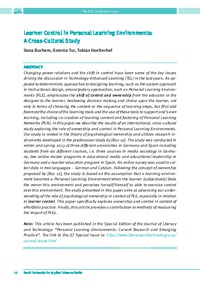Learner Control in Personal Learning EnvironmentsIlona Buchem, Gemma Tur, Tobias Hölterhof
Publikationsdatum:
|
 |
 Diese Seite wurde seit 9 Jahren inhaltlich nicht mehr aktualisiert. Unter Umständen ist sie nicht mehr aktuell.
Diese Seite wurde seit 9 Jahren inhaltlich nicht mehr aktualisiert. Unter Umständen ist sie nicht mehr aktuell. Zusammenfassungen
Zusammenfassungen
 Changing power relations and the shift in control have been some of the key issues
driving the discussion in Technology-Enhanced Learning (TEL) in the last years. As opposed
to deterministic approaches to designing learning, such as the system approach
in instructional design, emancipatory approaches, such as Personal Learning Environments
(PLE), emphasizes the shift of control and ownership from the educator or the
designer to the learner, bestowing decision making and choice upon the learner, not
only in terms of choosing the content or the sequence of learning steps, but irst and
foremost the choice of the learning tools and the use of these tools to support one’s own
learning, including co-creation of learning content and fostering of Personal Learning
Networks (PLN). In this paper we describe the results of an international, cross-cultural
study exploring the role of ownership and control in Personal Learning Environments.
Our study is rooted in the theory of psychological ownership and utilizes research instruments
developed in the predecessor study by [Buc 12]. The study was conducted in
winter and spring 2013 at three diferent universities in Germany and Spain including
students from six diferent courses, i. e. three courses in media sociology in Germany,
two online master programs in educational media and educational leadership in
Germany and a teacher education program in Spain. An online survey was used to collect
data in two languages – German and Catalan. Following the concept of ownership
proposed by [Buc 12], the study is based on the assumption that a learning environment
becomes a Personal Learning Environment when the learner (subjectively) feels
the owner this environment and perceives herself/himself to able to exercise control
over this environment. The study presented in this paper aims at advancing our understanding
of the role of psychological ownership in contect of PLE, especially in relation
to learner control. This paper speciically explores ownership and control in context of
ePortfolio practice. Finally, this article provides a contribution to methods of measuring
the impact of PLEs.
Changing power relations and the shift in control have been some of the key issues
driving the discussion in Technology-Enhanced Learning (TEL) in the last years. As opposed
to deterministic approaches to designing learning, such as the system approach
in instructional design, emancipatory approaches, such as Personal Learning Environments
(PLE), emphasizes the shift of control and ownership from the educator or the
designer to the learner, bestowing decision making and choice upon the learner, not
only in terms of choosing the content or the sequence of learning steps, but irst and
foremost the choice of the learning tools and the use of these tools to support one’s own
learning, including co-creation of learning content and fostering of Personal Learning
Networks (PLN). In this paper we describe the results of an international, cross-cultural
study exploring the role of ownership and control in Personal Learning Environments.
Our study is rooted in the theory of psychological ownership and utilizes research instruments
developed in the predecessor study by [Buc 12]. The study was conducted in
winter and spring 2013 at three diferent universities in Germany and Spain including
students from six diferent courses, i. e. three courses in media sociology in Germany,
two online master programs in educational media and educational leadership in
Germany and a teacher education program in Spain. An online survey was used to collect
data in two languages – German and Catalan. Following the concept of ownership
proposed by [Buc 12], the study is based on the assumption that a learning environment
becomes a Personal Learning Environment when the learner (subjectively) feels
the owner this environment and perceives herself/himself to able to exercise control
over this environment. The study presented in this paper aims at advancing our understanding
of the role of psychological ownership in contect of PLE, especially in relation
to learner control. This paper speciically explores ownership and control in context of
ePortfolio practice. Finally, this article provides a contribution to methods of measuring
the impact of PLEs. Dieses Konferenz-Paper erwähnt ...
Dieses Konferenz-Paper erwähnt ...
 Personen KB IB clear | David G. Harper, Sandy Hirtz | ||||||||||||||||||
 Begriffe KB IB clear | E-Portfolioe-portfolio, LehrerInnen-Bildungteacher training, Personal Learning EnvironmentPersonal Learning Environment | ||||||||||||||||||
 Bücher |
|
 Volltext dieses Dokuments
Volltext dieses Dokuments
 Anderswo suchen
Anderswo suchen 
 Beat und dieses Konferenz-Paper
Beat und dieses Konferenz-Paper
Beat hat Dieses Konferenz-Paper während seiner Zeit am Institut für Medien und Schule (IMS) ins Biblionetz aufgenommen. Er hat Dieses Konferenz-Paper einmalig erfasst und bisher nicht mehr bearbeitet. Beat besitzt kein physisches, aber ein digitales Exemplar. (das er aber aus Urheberrechtsgründen nicht einfach weitergeben darf). Aufgrund der wenigen Einträge im Biblionetz scheint er es nicht wirklich gelesen zu haben. Es gibt bisher auch nur wenige Objekte im Biblionetz, die dieses Werk zitieren.










 , 364 kByte)
, 364 kByte)  Biblionetz-History
Biblionetz-History